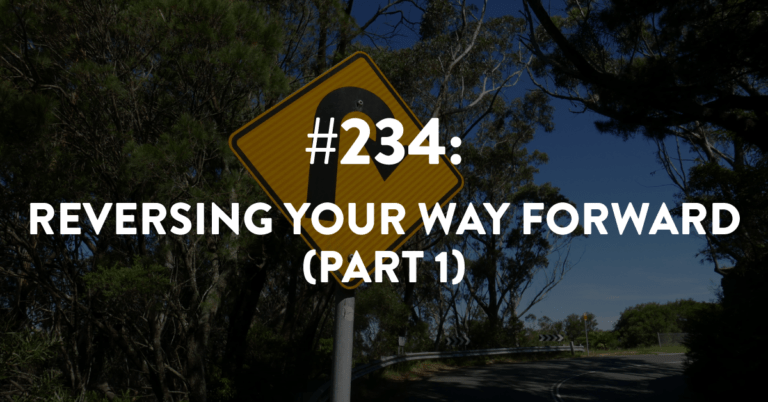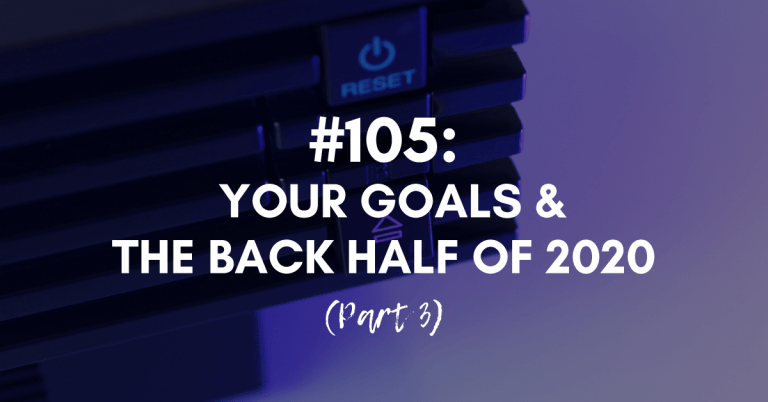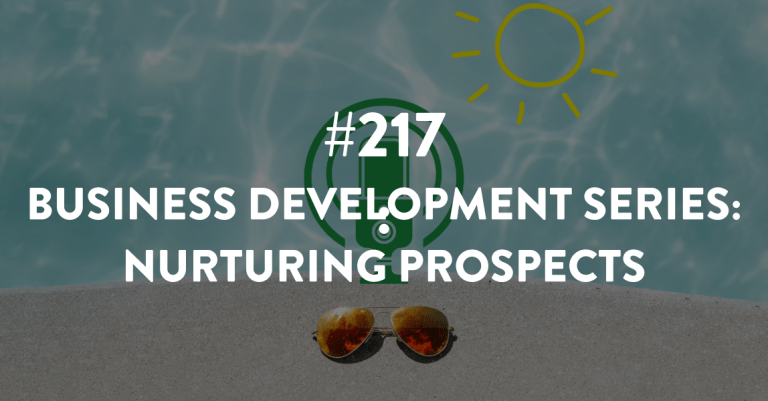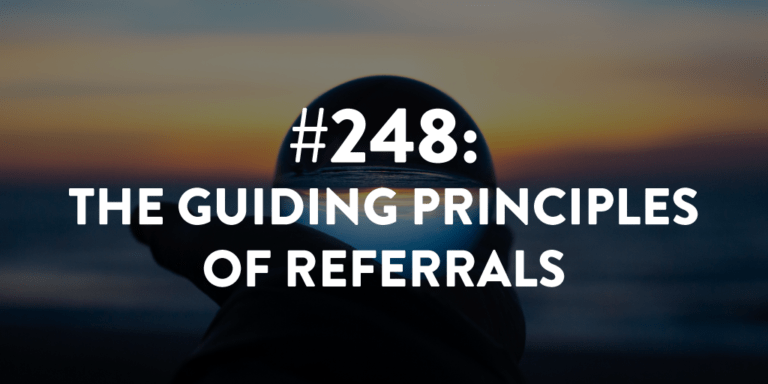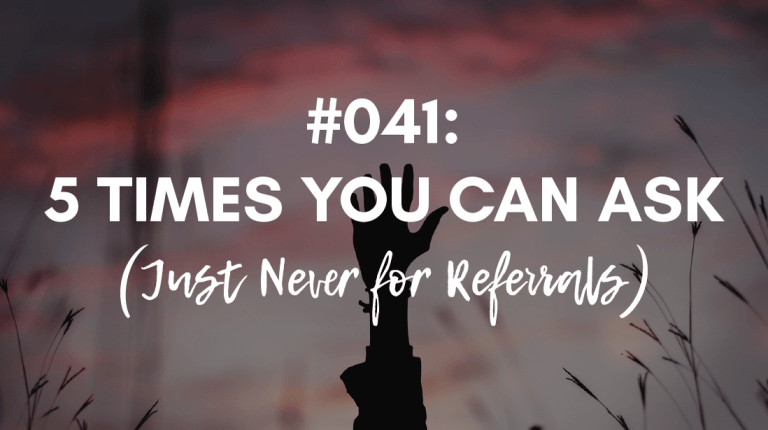Ep #290: Gaining Clarity with Your 2024 Referral Goals
Happy New Year! I hope you’re off to a fantastic start and ready to make this year your best one yet. As we kick off the new year, I want to help you gain clarity and set the right goals for referrals in 2024. So, let’s get started!
In this episode, we will talk about the importance of slowing down to speed up. We often neglect to assess our capacity before setting ambitious referral goals. Capacity refers to the number of clients you can manage without overwhelming yourself or your business. It is crucial to align your goals with the season of life you are in and what you want to achieve.
Next, take a moment to reflect on the referrals you received last year. How many of them turned into paying clients? What was your overall closing ratio? By analyzing these metrics, you can gain valuable insights into your referral success and make informed decisions for the future.
Finally, decide how much you want to grow this year and what that growth looks like for your business. Whether you aim to maintain your current success or strive for significant growth, clarity around your growth expectations will help you set appropriate referral goals.
By taking these steps now, you can set realistic and achievable referral goals for 2024. Be sure to tune into our next episode, where we will start to calculate your referral goals.
Links Mentioned During the Episode:
Want to attend my free, live training on making your Referral Explosion Goals a reality this year? Then submit an application to join the Building a Referable Business™ coaching program. If approved, we’ll send you the training dates (two to choose from). There is no obligation to join BRB after applying or attending the training.
Want to work with Stacey as a VIP through her Referrals in a Day program? Check out the program to learn more and submit your application. Only 1 (maybe 2) spots remaining for first quarter in 2024.
Next Episode:
Next episode is #291, which is another episode created with you and your needs in mind.
Download The Full Episode Transcript
Read the Transcript Below:
Stacey Brown Randall: Well, hello 2024. Welcome to the new year. And you picked an excellent way to kick off your new year by listening to get another episode on the Roadmap to Referrals podcast.
You’ve probably heard the saying, to speed up, you first need to slow down. It applies to so much in life. And when it comes to having a referral explosion this year, oh, my friend, it is a necessary step. So let’s take that step together in this episode.
Hey there, and welcome to Episode 290 of the Roadmap to Referrals podcast, a show about helping you build a referable business. I’m your host, Stacey Brown Randall. My journey from a business failure to a successful business now 10 years in, I know generating referrals naturally and consistently has made all the difference. Working with clients around the world, we leverage the science of referrals, protect relationships above all else, and help you build a referable business.
All right let’s dive into this episode, our first episode of 2024. And it’s such a great time to talk about gaining clarity and specifically gaining clarity around your goals for referrals this year.
So I’m going to take a couple of episodes, and we are going to break this down. And it’s going to start, of course, with this first episode. And we’re really going to unpack some of the things we need to have locked and loaded and understand crystal clear so that we can have the right clarity to set the right type of referral goals for this year.
So there’s a couple of things I’m going to talk about in this episode and we’re going to do a little bit of backtracking. That’s that slowing down to look back to be able to look forward so that hopefully you can move faster to accomplishing your referral goals this year.
So like I said, we’re going to break this down over a couple of episodes, so I want you to stay with me throughout the next couple of weeks. I mean, I want you to stay with me throughout the entire year and come back and listen to every weekly episode. But specifically, for helping you gain clarity around your 2024 referral goals, I want to make sure you kind of stick with me with these episodes.
So as you’re listening to these, there’s going to be some work for you to do. That’s OK, because you’re a business owner, which means you are perfectly capable and completely willing, right, to take a minute, pause, and do the work. Because that is going to give you everything you need mapped out to have the referral success you want this year, starting with the right type of clarity.
So, first thing I want to talk about is capacity. And that may feel like kind of a weird place for us to start when it comes to really diving in and understanding what our referral goals should look like, is why are we starting with capacity, because actually it defines everything.
And I think it’s really important, and I think it’s also something that business owners overlook, is what their capacity actually is.
A lot of times, we’ll set revenue goals and new client goals or referral goals or whatever it is for the year or for the next couple of years, however you’re used to setting goals. And we’ll set really big goals, which are great.
Or maybe you’ll set medium-sized goals in comparison for yourself. I’m not saying your goals are medium-sized goals, but whatever goals you set, I find that people don’t actually tie that back to the capacity that their business can support.
I spend a lot of time, like probably maybe more than I should, but I spend a lot of time thinking about if I do X, Y, Z, whatever that is, what is that going to look like on the day in and day out of me running my business?
So when I say yes to things or decide I want to launch something new or decide I want to change up something, I spend a lot of time before I say yes to that, I’m like, okay, wait, what does this look like in terms of the amount of work? And when am I going to do that work? And what are the outcomes and the objectives that I want to get out of all that work that I’m going to do?
This may sound a little like, I don’t know, like a little grinchy, so to speak, just thinking about the Christmas holiday or a little bit of like a bah humbug of like, wait, you set goals and then immediately you go into what is this going to look like in terms of making the work happen?
And I don’t do that from a negative place. I don’t do that from like, oh my gosh, that’s so much work. And I don’t do it from a place that, you know, a lot of times when you think about the science behind setting goals, and you’ll set goals and then your brain will go into like the 15,000 reasons why you can’t do that.
And it’s like your brain’s way of keeping you safe from like stretching yourself because, you know, your brain likes routine, and it likes predictability, and it likes keeping you where you are. It likes a comfort zone for a reason, because it is comfortable for your brain and your subconsciousness.
And so when we set goals, or we set expectations, or we decide we’re going to do something different, there is a place in our brain that goes completely like, no, no, no, no, no, no, no. This is not why this is going to work. That’s not what I’m talking about.
I don’t come at the, okay, what does it look like to make this happen from a negative place. I come at it from a perspective of, okay, I want to make this happen. Let me back into what that’s going to look like. And does that align with how I’m trying to live my life and run my business in the season that I’m in?
And so when I talk about capacity, I want you to think about it from the perspective of what your business can actually handle based on the season of life you are now in and that you want to do.
If you are in a season of life where you’re all about, how much can I grow? How much revenue can I make? Great. Love it. Go. But I feel like sometimes as business owners, we set goals for our business, and we don’t reconcile them with where the heck we are in life and what we actually want out of this time in life.
Which is how we end up in a place come like March or maybe July or maybe September, where we’re like, I’m working entirely too hard to reach these goals. And it’s not fitting in nicely with where I am in life. And I’m running around like a crazy person because I’ve committed to way too much. Because we didn’t take advantage, not advantage, but we didn’t take a really strong look at where we are in a season of life.
Now, your season of life may be very different from mine. I also believe that seasons of life aren’t like 18 years long. I just picked 18 because, you know, that’s when the kids finally leave. I didn’t pick like, oh, I’m in the kid season of life. No, no, no. I think seasons are way shorter than that.
I am in a season of life where I have a couple of years left, God willing, that the boys will head off to college. And I have a few more years past that before my middle schooler gets through high school as well. And this is a particular season of life.
The season of life I was in when my kids were toddlers looks different from this season now. And so it’s really important that we pay attention, and we like just take a beat, right, like just take a minute and think to yourself, okay, this is my season of life. This is how much I’m willing to put into my business or my personal life or whatever it is, right?
Like maybe you’re in a season of life where you’re going to start having children. And you’re like, I want to grow, grow, grow until I decide that I want to have kids, whether, you know, your spouse is having kids, you’re having kids, your partner’s having kids, whatever it is, and you’re in this grow, grow, grow mode, grow, like good. I was there. I know what that’s kind of like.
But you also have to recognize when you enter different seasons. If you’re in the season where you’re now an empty nester and you’re like, all right, let’s go. The kids are off to college. Hopefully they stay there. And I want to take my business to a different level. I will be in that stage in the future. I’m actually secretly, not so secretly, really looking forward to it.
And so I think recognizing where you are and how you want to grow is important and how you want to structure your business and model your business. And quite frankly, let me just put it bluntly, how many hours you want to work. That comes down to feeding that season of life.
So the first thing I want you to pay attention to when you’re getting clarity on what you want your referral goals to be is to first pay attention to the season of life that you are in and the capacity that your business can support with that.
Now, people look at capacity in a lot of different ways. You guys know if you’re a longtime listener to this podcast, I like looking at things as simple as possible. Like, what’s the easiest, least amount of words definition to define something?
So for me, capacity is the amount of clients I can work with in a year without having to add more either teammates or contractors or time on my calendar or more processes and systems and things to support that.
So I look at, okay, based on what my plan is for 2024, what is my capacity? Like how many clients can I work with? Now, I do pay attention to growth expectations. I do say, hey, I want to grow more here. I want to grow more there. But I’ve already mapped out in my mind and probably on a piece of paper exactly what that’s going to look like to be able to grow.
And so that’s the connection I want you to make. It’s not about setting these audacious, amazing, incredible goals. It’s also about recognizing, hey, those goals are just work. So how am I going to get the work done? How does that goal fit into the season of life that I’m in? And then how does that all pour itself out to into typically a number, which is capacity, which is the number of clients you can work with.
Now, you probably have different capacity numbers based on the different service offerings. So in my business, I have a coaching program that I work with people for an entire year. And I also allow them to stick around after that year if they want to, on what we call our maintenance plan that they can renew and stay in my coaching program, which is building a Referable Business, or BRB.
But that’s a limited number of people who can be in that program. I keep it small because I know my client’s businesses. I know when I’m talking to Phil, he’s an attorney, and I know exactly what kind of attorney he is. I know when I’m talking to Lacey, that she’s an interior designer, and I know exactly her type of ideal client.
So that when I’m having conversations, or I’m answering questions, or I’m giving advice when it comes to why they’re in my program, which is to get more referrals, I know exactly how to answer those questions based on where they are and what they’re trying to accomplish.
So that group is kept small. So I know, we tap out around 30, 35 members in a year. It just is what it is. And we tap out, we go on a wait list. And I don’t really bring anybody else on.
And so it’s important for me to recognize that program’s never going to go to 60. Yes, there are other ways to scale that and make more capacity, and that’s fine. But that’s not what I’m looking for right now in this life season.
But that’s not the only offering I have, right? So yes, I have my coaching program. That’s a mix of one-on-one and group, right? But I also have my VIP. Which is actually, when I do a VIP it looks like, oh it’s just two days with someone but the pre-work that goes into me doing it for them and building their entire referral strategy and then going to spend two days with them and then supporting them on the back end, that’s actually a considerable amount of work.
And so I also know that when I’m looking at my VIPs I really don’t need or want more than like 10, maybe a dozen a year. That’s what I look at when I’m looking at capacity. So I look at what it means in the different levels or the different service offerings.
And then, of course, I have my online programs, which is a great starter place for people who are not ready yet for my coaching program or VIP, or maybe they won’t ever be, but they still want to learn some of my strategies.
We have our online programs, our self-study programs as well. And that capacity is much more what I would say unlimited. It also doesn’t get a ton of my focus either, just based on the fact that it is an online self-study program that people go through and there’s no handholding from me in that.
So when I talk about capacity and you’re relating this back to your business, what I want you to pay attention to is based on the service offerings that you have, what is the capacity of new clients that you can handle?
If you are like a CPA, or maybe a financial advisor, and the whole point is for your clients to stick around year after year after year, you don’t start at zero on January 1st. You start with a bank of clients. Maybe you’re trying to replace some of the ones that you lost last year. Maybe you’re trying to add more so that you can continue to grow.
Most people have that, hey, I need to bring on x number of new clients to maintain where I am. That’s one number they’ll have. And then there’s, hey, if I want to go to this next level or grow to this next level, here’s how many more clients on top of that I need to bring in as well. I look at it the exact same way. So it just depends on what your business is.
If you’re an interior designer or a real estate agent, you’re probably thinking, on January 1st, I do start over. Maybe I have some closings from last year that are happening in 2024. Or if you’re an interior designer, maybe you have a project from last year that’ll end this year, and you’ll get your final payment. but you need new clients every year. Like that’s kind of how the system works.
And so they’re just different models. There’s not right or wrong, it just is what it is in terms of your business. And so as you’re thinking through capacity, the reason why I’m spending so much time dedicated to helping you determine what your capacity is for this year is because you shouldn’t set a referral goal until you’re really, really clear on how many new clients you want.
So when I’m working with someone and they’re like, I need two to three clients, typically that means their clients are worth six figures or more to them, right? Like when someone’s like, hey, if I just brought on two or more new clients this year, I’d be gangbusters, right?
Like, that’s an entirely different capacity conversation than someone who’s like, I need 50 new clients this year, or more. I need 75. I need 100, right?
And so it’s not comparison. It’s what do you need based on the model of how you have your business structured, of how you work with your clients, of what your service offerings are, and then, of course, the capacity that you have. But all of that is wrapped in understanding what you want 2024 to look like.
I think it’s amazing if you want to set big, audacious goals. I think it’s amazing if you want to set smaller quiet ones. We each get to do business on our own terms. And I don’t think that’s celebrated enough in business as it should be. So I just think that’s something for us to consider.
All right, so I probably went a little longer on the whole idea of capacity than I had planned on. I was planning on not probably spending 15 minutes, I think, on capacity. But I just think it’s really, really important.
Let’s move on because there’s some other things I need you to have, so that we can keep going with the next couple of episodes in this series on really getting the right clarity that you need for your referral goals. All right, so let’s talk about the next piece that’s really important in this clarity model.
Hey there, pardon the interruption. It wouldn’t be a new year if I didn’t plan to do a live teaching. Call it a workshop, a training, a webinar, whatever. Coming up in a few weeks, I’m offering two different times for you to choose from so that you can learn how to finally receive the referrals you deserve this year.
In this training, I teach you how to strategy stack and calculate your referral potential. Plus, I share how I guide my clients to success inside my coaching program, Building a Referable Business, or BRB for short.
So to attend the training, you need to first submit an application to BRB. There isn’t any obligation to join BRB to attend the training, but the training is for those who are a fit for the BRB coaching program, which is why to get into the training, you have to submit an application. You can find all the details of the training, the program, and the link to complete your application at StaceyBrownRandall.com/referable. Okay, now back to the episode.
All right, so we have capacity. We understand what we’re looking at in terms of revenue or number of new clients, returning clients, right, the things that when we’re looking at those metrics of what it looks like for capacity.
The other thing I believe that you need to spend some time doing before you start setting goals is you need to do a little bit of time reviewing your last year results. So what I pulled out and what I’m looking at that you cannot see because I’m still yet not doing a video podcast. It’s audio for me right now, audio only.
But the other thing I’m looking at is actually the pre-work that my BRB coaching clients did before they attended the retreat. Well, they did it whether they attended the retreat or not that we do every December. But I’m actually looking at the pre-work document. I’m going to walk you guys through this.
And so here are the metrics I want you capturing based on last year’s results. So the first one is the number of referrals that you received in 2023. How many referrals did you receive?
Remember, guys, you’ve got to define referral correctly. a referral comes from another human. A client cannot refer themselves. That is called a repeat client. It doesn’t count as a referral. And of course, the referrals that don’t come from a human aren’t probably a referral either. So a networking group doesn’t refer you, someone in that networking group refers someone to you. So keep that in mind.
It’s the number of referrals received in 2023, which means they had to come from another human. And you have to be able to capture that human’s name. That doesn’t mean you’ll have perfect results. Maybe your tracking wasn’t that great. Don’t worry, we can change that moving forward.
But it is something for you to consider, that you know that right at this moment, who are the clients and prospects that were referred to you. Because I need you to know the number of them. How many referrals did you receive in 2023?
The next data point that I need you to be able to know is the number of those referrals that became paying clients. So let’s just say, I’m going to use really round numbers here because I like round numbers. They make math publicly easy for me.
So let’s say you received 20 referrals last year, and 10 of those referrals became clients. So 10 said yes to working with you, and 10 said no or not yet, right? That would then give you the third metric, which is your overall closing ratio of referrals, which at this, using my example, would be 50%.
So I got 20 referrals, 10 became clients, 10 did not or have not yet, and that gives me an overall closing ratio of 50%. So again, we want to know the number of referrals received last year, the number of referrals that actually became paying clients, and that will give you your overall closing ratio of referrals.
We also want to know the amount of revenue or commission that came from those closed referred prospects into paying clients. So of those 10, using my example, of the 10 that became clients, I want to be able to mark how much revenue, or if you work on a commission model, but how much revenue or commission did I receive from those referrals.
It doesn’t matter if you haven’t received all the money. Just write down what you will be receiving. I know some of you take payments in different like, we take 50% up front and then 50% at six months or whatever it is, right? It’s the amount of total revenue that that client is going to be paying you.
And then, of course, we had 10 people who said no or not yet, which could also mean some people are still in process. So of those 20 referrals I received, 10 became paying clients. Let’s say, for sake of our example, of the other 10, five are like hard, fast no. But the other five were more like a not yet, and I’m still working on them.
If I think they still have potential, we consider that the amount of revenue or commission that’s still in play or in process from those referrals. So what’s the revenue? If I did close those other fives that are more like, I haven’t gotten a no, I haven’t gotten a not yet, what is the revenue that could still be in play? Because that’s actually important as well.
Not everybody that is referred to you in one year will close within that year. Sometimes it’ll be a year later before they actually close. So we then want to, of course, track the amount of revenue or commission that’s still in play and process from those referrals, the ones that could still close into a client.
We also want to make sure we understand, of those 20 referrals, how many of them were not a fit? Maybe you had to refer them out. Maybe you just had to tell them no. We need to know who’s not a fit.
And then the last metric we want to make sure we’re tracking is the number of new people who started referring us. So how many new referral sources did you add last year?
Now, to be defined as a brand-new referral source, that means they gave you their very first referral. If they’ve referred you in the past, of course, they’re an existing referral source, but we want to know how many new people started referring you.
You know, some of my clients, that is actually where the bulk of their growth in one year will come from. It won’t necessarily be from existing referral sources referring them more. I mean, sometimes it will, but sometimes it won’t. Sometimes the bulk of the referrals that they receive in a year come because they cultivated brand new people referring them.
So you may not be doing any active cultivation of brand new referral sources, but it doesn’t mean it may not happen for you, right? And so if you had anybody refer you for the very first time, let’s make sure we know who they are, and let’s make sure we know how many people that we have were brand new referral sources.
So those are the metrics that I want you tracking from last year as we look forward. Now, here’s the thing. I’m going to give you some time to complete this piece of work, because it’s really important you bring this to next week’s episode as we dive into calculating your referral goal.
So if you don’t already have this information at your fingertips, take some time, please, please take some time and actually work through this so you have this available.
Now, we’ll put this information, of course, in the show notes page so you can go find that. And the show notes page for this episode is StaceyBrownRandall.com/290. That’s 290 for episode 290.
So you can kind of access these results and get a screenshot or a snapshot or just kind of look at what they are. You may have to stop, rewind, and re-listen to this part again. But this is the data you’re going to want to pull because where you’re starting from in terms of what last year looked like, defines the type of goals you’re going to be setting.
This is the thing that I think people don’t do. They don’t ever really look back and be like, well, where am I? If we want to get to B, we kind of need to know where we’re starting from, from point A. So if we’re trying to get to point B, well, where the heck is point B in relation to point A in terms of where we started from?
That’s this data. That is last year’s results when it comes to referrals. That is that information, that data. What does that look like? What are those numbers? Because we need to use that to set our calculations for our goals for referrals for the rest of this year, for 2024.
Okay, and here’s the third thing I want you to consider. When you are trying to gain clarity on what your referral goals are gonna look like for this year in 2024, you need to just make sure you’re very clear on your growth expectations.
I’ve talked about this a little bit before when I was talking about capacity and understanding where you fit with capacity and relating that to your life season. But get really clear on if you want to grow and how much you want to grow and what does growing look like in terms of maybe scaling, new staff, new contractors, new time on your schedule, new tasks on your to-do list, new processes, new systems.
There’s absolutely nothing wrong with being like, hey, last year was a great year, and I would like a repeat of that. That’s a fantabulous goal. And there’s nothing wrong with saying, hey, last year was a not great year, or it was a great year, but I still want to do more. But get clear on your growth expectations. Just kind of have an idea. What is it that you are aiming for? What is it that you are looking for?
So when we are setting our goals for referrals for this year, we want to make sure that we’re really clear on our capacity and how that capacity fits within our life stage and what we want for our business and what capacity actually looks like based by our different service offerings.
We also want to make sure we understand, well, what the heck happened last year? And we have the data, the metrics pulled to really be able to review those hard numbers. And hard numbers are numbers that are in writing, and they’re real, and they’re based on what actually happened from last year.
So go back and listen to that section of this episode so you can pull your data and have it for next week’s episode. And then, of course, just take a minute to get really clear and to maybe make peace with what you want your growth expectations to be. Grow a lot, grow a little, don’t grow.
Maybe some of you may even want to scale back. Maybe you had such a huge growth year, right? It doesn’t matter. We’re not comparing this stuff to anybody else. This is for you and you alone.
But make sure you go through these three parts of this episode and bring all those thoughts and all that data and all those notes in writing, please. Bring all of that to next week’s episode because that is where we are going to start diving into calculation of your referral goals.
Okay, everything I’m talking about, the resources that we mentioned in this episode, as they are with every episode, can be found on that episode’s show notes page. And the show notes page for this episode is StaceyBrownRandall.com/290. And Stacey has an E.
All right, we’re back with another great episode next week created with you and your needs in mind. Until then, you know what to do, my friend. Take control of your referrals and build a referable business. Bye for now.


